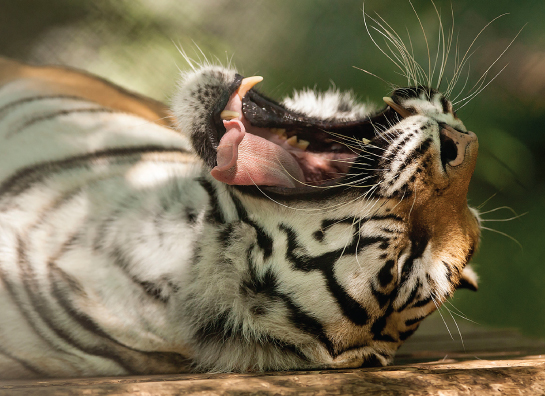Let’s get the disappointment out of the way now: No, you can’t touch a tiger at Carolina Tiger Rescue.
 However, you will get to interact with them unlike you can at any zoo, separated only by chain-link fence. In order to respect the wildness of the wildcats, the 55-acre sanctuary in Pittsboro takes a completely hands-off approach to caring for its 70-some tenants, which include not just tigers, but also lions, cougars, ocelots, servals and more.
However, you will get to interact with them unlike you can at any zoo, separated only by chain-link fence. In order to respect the wildness of the wildcats, the 55-acre sanctuary in Pittsboro takes a completely hands-off approach to caring for its 70-some tenants, which include not just tigers, but also lions, cougars, ocelots, servals and more.
Many of the animals originated from roadside zoos or other facilities that closed. However, a surprising number were personal pets. North Carolina has no state restrictions on private ownership of wild animals, meaning wildcats big and small often fall into the hands of people unequipped to handle them.
“You can go online and buy a tiger today,” said Keith Gavigan, education director of the rescue — but that’s a very bad idea, even for the smaller cats. Wild animals are wild, no matter their size, and attempting to keep one as a pet is irresponsible and destructive for both the animal and owner, he said.
On a tour you’ll learn the cats’ stories, from the tigers found walking down the street in Charlotte, to what Gavigan says makes white tigers “the most genetically messed up of animals.”
Carolina Tiger Rescue doesn’t follow a drop-in schedule. Public tours are available by appointment on Saturdays, Sundays and holidays only. Twilight Tours, held seasonally April through October on Saturday evenings, showcase the cats to a 13-and-older audience during their most active time of day.
A regular tour usually includes about 20 animals and a walk through the sanctuary. However, the rescue offers tours that go a step beyond, taking participants off the beaten path into a day in the life of the keepers.
“It’s hard to knock out a tiger to inspect them, so there are different behaviors we can induce. We train them to put their paw against the fence to examine, or lean against it to draw some blood,” Gavigan said. And those who take the Behavior Training with a Keeper tour can witness those training techniques firsthand.

Feeding with a Keeper, on the other hand, gets patrons up close and personal with the diet of the carnivores, from preparation to delivery.
Be prepared for the animals to watch you, too. “It’s not like the zoo,” said Pam Fulk, executive director. “At the zoo, people are there all the time and they aren’t new. We try to keep one or two days a week where we don’t have anything so when they see people, they’re interesting.” Gavigan noted that the tigers pay particular attention to keepers and visitors when they are ill or injured, a testament to their predatory perception.
Learn about the cats at carolinatigerrescue.org.
Fun fact: Binturongs, also called bearcats, are neither bears nor cats. They smell like corn chips.























